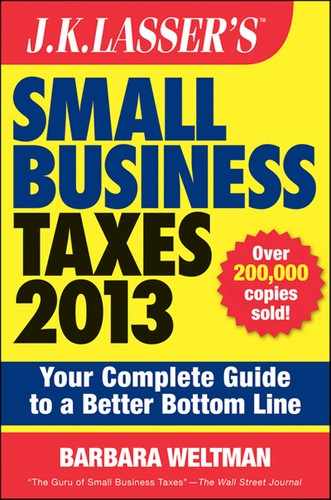General Recordkeeping
The tax law does not require you to maintain books and records in any particular way. It does, however, require you to keep an accurate and complete set of books for each business you operate. Statistics show that this can be an awesome task averaging 10 hours each week (that amounts to about 520 hours each year) for small business owners.
Set up your books when you begin your business. Your books are based on your choice of tax year and accounting method, as explained in Chapter 2. You also need to choose a bookkeeping method—single-entry or double-entry. If you are a service business, single-entry bookkeeping may be sufficient. However, if your business involves inventory or is complicated, double-entry should be used. If you use accounting software to keep your books, you will not be aware of the bookkeeping entry method in use; you merely input income and expense items and the program does the rest.
Your books should be set up with various accounts in order to group your income and expenses. The broad categories of accounts include income, expenses, assets, liabilities, and equity (or net worth). Within these accounts you can keep various subaccounts. For example, in an account called Expenses you can have subaccounts for advertising, bad debts, interest expense, taxes, rents, repairs, and more. In fact, your subaccounts should reflect the various income and deduction topics discussed throughout this book.
Technology for Recordkeeping
More and more businesses are using computers, tablets, and smartphones to maintain books and records rather than having bookkeepers make handwritten entries. Computer-generated records save time—an important commodity for the small business owner—and generally are more accurate than handwritten entries.
The IRS accepts computer-generated records if they are legible and provide all the necessary information. You are required to keep a description of the computerized portion of your accounting system. You must keep this documentation as long as you keep the records themselves. Your document should show:
- Applications being performed
- Procedures used in each application
- Controls used to ensure accurate and reliable processing
- Controls used to prevent the unauthorized addition, alteration, or deletion of retained records
Use recordkeeping software that facilitates recordkeeping both for tax purposes as well as for financial matters. Using software and cloud-based versions of programs such as Intuit’s Quickbooks Online, Online Simple Start, Quickbooks Pro; Sage Peachtree Accounting; Simply Accounting; FreshBooks; or AccountEdge enables you to forward data to your tax professional as well as transfer information into tax return preparation programs at tax time, saving you both time and money.
An increasing number of accounting products are now accompanied by apps for tablets and smartphones to enable you to record information on the fly. For example, if you are a QuickBooks user, you can view your company’s data, such as receivables and bank account balance, on your iPhone with QuickBooks Online app. FreshBooks, a cloud-based accounting solution, offers MiniBooks app for the iPhone; it enables you to send an invoice from your mobile device.
Your books alone do not entitle you to deductions; you need supporting evidence. This evidence includes sales slips, invoices, canceled checks, paid bills, time sheets for part-time help, duplicate deposit slips, brokerage statements on stock purchases and sales, and other documents that help to explain a particular entry in your books. Certain deductions—travel and entertainment expenses and charitable contributions—require specific types of supporting evidence, as explained later in this chapter. The IRS considers your own memoranda or sketchy records to be inadequate when claiming deductions. Keep these records and documentation in an orderly fashion. Use files or other storage facilities to retain receipts and other evidence.
Keep your files in a safe place. For example, keep a copy of computer files off premises, and store paper files in a fireproof safe. If you lose files with receipts because they were not stored safely, you may lose deductions and face penalties as well. If you “lose” records before or during an audit, you may be charged with a hefty negligence or accuracy-related penalty. If, despite your best efforts, files and records are lost or destroyed by a casualty (such as a fire, storm, earthquake, or flood), you may be permitted to reconstruct records if you can prove those records existed before the casualty. Of course, reconstruction takes considerable time, and it is probably impossible to reconstruct all of your expenses. Therefore, take special care to safeguard your records.
Electronic Imaging Systems
Storage of receipts and other records in paper form makes retrieval of wanted items difficult. This is especially so for large companies, but it can be problematic for smaller businesses as well. Recognizing the problem, the IRS now allows books and records to be maintained by electronic imaging systems.
If an electronic imaging system is used, it must ensure accurate and complete transfer of the hard copy or the computerized books and records. It must include:
- Reasonable controls to ensure the integrity, accuracy, and reliability of the system
- Reasonable controls to prevent and detect the unauthorized creation of, addition to, alteration of, deletion of, or deterioration of records
- An inspection and quality assurance program evidenced by regular evaluations of the electronic storage system
- A retrieval system that includes an indexing system
- The ability to reproduce legible hard copies of electronically stored books and records
In the past, most small businesses could not undertake the expense of using an electronic imaging system for their books and records with the technology that was available. However, today’s technology allows you to use an alternative imaging method that is acceptable to the IRS. You can transfer data to a CD-ROM—you burn the information onto the disk and cannot alter it thereafter. You can scan the information to be transferred into your computer and then transfer it to the disk.
